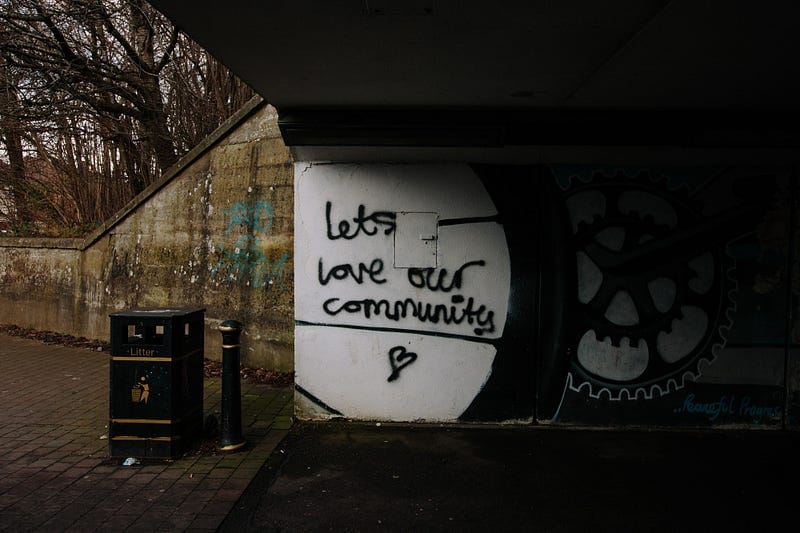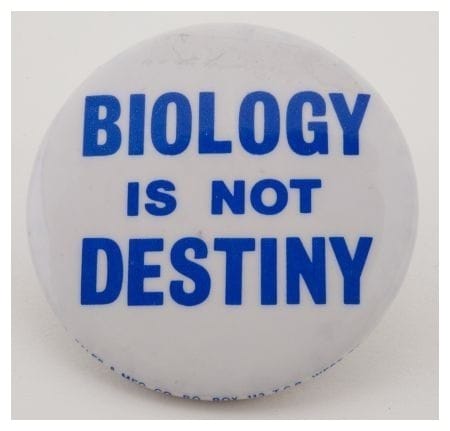Why TERFs only seem to care about gay surrogacy
Something we all ought to learn from

I came across this comment today in reply to a discussion on anti-surrogacy activists, and I think it’s a thing worth talking about because I’ve spent some years now researching the anti-trans movement, the growth of the UK evangelical right over the last decade, and wider international links these have.
A closer look around the conversation shows that, although Claire Heuchan (the original poster, a radical feminist and gender critical commentator) shows a clear bias in general towards stories about gay men, she joins in challenging the Orthodox Christian participating in the anti-surrogacy conversation stepping over into explicit homophobia prompted by her thread criticising Tan France and his husband for using a surrogate to become parents.
So Claire isn’t a homophobe at least consciously. What’s going on here?
I think, like with the situation around anti-trans feminist activism, the answer is that trans-national evangelical networks have been effective, through building out a palatable cisgender women’s solidarity wing, at gaining a significant degree of penetration into radical and institutional feminist movements. Even just by being part of the same networks sharing information, resources and news stories in a relatively organic way, without any particular coordination at all or any sinister “masterminding” of the type speculated on, this is enough to exert a significant influence in how feminists within those circles discover news stories, which stories get circulated for critique, and so on. And having layers of ideological mediation means these groups which function as a wider campaigning network against surrogacy (as well as frequently against porn, sex work, and increasingly painting trans rights as a threat to women), also serve as a soft-influence on the wider movement towards more conservative and reactionary views of the world.
I want to be clear, while this theory of mine is not hugely rich in empirical data, this isn’t a conspiracy theory. I don’t think there is a conspiracy happening here, and I think this is a very similar organic phenomenon of social scenes to the reasons why the trans rights and trans liberation movement has historically had an excess focus on transphobic feminists rather than more serious and better funded adversarial organisations ourselves. I’ll use that example in the hope that people from outside my own choir might consider how this dynamic plays out in their own circles.
Trans hyperfocus on TERFs
The vast majority of transphobic violence is done by men. As a white trans woman living in the UK, the vast majority of transphobic violence I’ve experienced has been done by specifically heterosexual cisgender white men. Often young, between late adolescence and mid thirties. The first such incident I experienced I was 16. The last such incident was last year and though not physical involved threats from a man who lives in my area only 3 metres away threatening to mutilate me genitally in front of my 15 year old child who was terrified and crying. I never forget this fact when I’m thinking about the issue of dealing with homophobia and transphobia in my community, because I’ve literally had a fear of straight white men’s capacity for violence beaten into me (among other things).
However, when it comes to the communities we (trans people) have historically relied on as sanctuaries, as safe spaces, as places to draw strength from, for me and most trans activists that’s been the wider queer community. What for me when I was younger and more isolated and the trans community were less out of the closet, was very much the LGB(t) community, and often connections I had through doing anarchafeminist and queer activism, in the streets, and through the NUS. It was at an NUS LGB conference (as they were called in the early 00s) that I first had a lesbian feminist, a senior member of the student union movement, warn me about “those trans people”. Now beatings are hard, but they’re also rare. Day to day, the knowledge that there are transphobes in your own organisation, not just people who maybe don’t really care for trans people, but people who will conspiratorially warn you that trannies are a danger if they think there’s no trans person watching, that’s not such a safe space. And I imagine transphobes imagine they face some equal but opposite threat from us — I have to admit the idea of driving every single serious transphobe out of our movements so we can finally get on with moving on from given a chance brings a smile to my face, but I don’t accept there’s a moral equivalence between the right to be transphobic and the right to be trans.
We all have our echo chambers — the limits on our horizon in terms of things happening we care about. The issue that you have to deal with as a pretty much constant struggle within your local political environment (typically for me as a younger trans activist 15 years ago this was transphobic feminists trying to drive me out of the few spaces where I had any protection from the violence outside at all) is the one that you end up focusing on to some extent when your movement becomes as much a subcultural “scene” as anything focused on changing the world outside, and to an extent that’s what a lot of queer and trans rights ended up being for a while. There were queer bars that would kick out well known TERFs, there were retaliatory blog posts, and varying scales of nastiness over fallout. That’s not to say this sort of scene isn’t a useful thing in some ways — these can be incubators for survival, nourishment, inspiration and art. Community isn’t a bad thing, it’s just not everything.
In the meanwhile, because most of us were not particularly adjacent to Christian evangelical and nationalist communities, nor anywhere near the halls of power where these organisations have continued to hold a degree of sway (particularly via religious conservatives in the House of Lords), and because most of the anti-fascist politics any of us ever did focused on street hoolies in the BNP, EDL, and others, over polite guys in suits with a bible and money as their main weapons, a lot of us I think didn’t really see the rise of evangelical Christian influence around us coming. The backlash against Stewart Lee’s musical “Jerry Springer: The Opera” and the surprising power of the suppression of free speech under prohibitions against blasphemy should have been a warning, but I don’t think it registered to most of us.
Feminist journalist Sarah Ditum noticed this back in 2016 — that trans activists weren’t protesting outside of an evangelical conference which was explicitly about the supposed Transgender Agenda, and how to stop it (including contributions from people who were involved in the original Section 28 campaign, from watching the conference videos). I’ve never yet received a reply from Ditum to emails asking how she heard about this conference, because it doesn’t seem to have been widely advertised outside of evangelical circles, but she’s absolutely right, there was a simple lack of attention to these groups.
We’ve now moved on in 5 years of rapidly rising transphobia, and this is happening outside of our social/activist scenes, in the outside wider world, measured in hate crimes, and a constant barrage of anti-trans stories in the media as well as the gradual exclusion of trans journalists who had been previously getting a foothold in the media. Mysterious large donations that seem not really to be plausible sums for feminist or grass roots activists appear in tens and twenties of thousands in “crowd” fundraisers online for transphobic campaigns, connected by friendly relations with the TERF wing of the feminist movement, but also not entirely of it in many cases, and with a hand always reached across the aisle to religiously motivated groups who are more than happy to have a secular front to repeat scary stories about psycho trans perverts coming for your children. The religious right has hit a very powerful and effective strategy and yet, I think more out of habit than anything else, the queer political “discourse” is focused more than anything on TERFs. We’ve fallen into an error of acting based largely on who and what we know and in my opinion it no longer really serves the fight we have today, as opposed to the fights we had 10 years ago.
So what’s this got to do with anti-surrogacy feminists?
We’re not the only ones with a blind spot. In 2015 when we were in blissful ignorance ignoring the growing religious anti-trans threat, Julie Bindel was writing articles against surrogacy for gay men in New Feminism. New Feminism is (according to wikipedia) a:
“form of Christian feminism that not only emphasizes the integral complementarity of women and men, rather than the superiority of men over women or women over men, but also advocates for respecting persons from conception to natural death.”
While that description is made of common English words, the words are used in a technical way which syncretises elements of feminism and evangelical Christian anthropology that I suspect most readers will be unfamiliar with, so I’ll break those down with links.
“Integral” here is probably a nod to Janice Raymond’s radical feminist Ethics of Integrity concept. This originated with her book The Transsexual Empire, where she argued that there is a moral imperative to be integrally ourselves, and that transsexuality violates this by surgically and hormonally altering our “natural” bodies. If this concords with a lot with Christian morality and ideas around nature, that may not be too surprising to people who know her previous academic career before becoming a feminist, and Ethics of Integrity was cited for years later as a principle around feminist responses to IVF and other reproductive issues.
“Complementarity” as a concept on the other hand is from Christian anthropology largely invented by successive recent popes to make an argument that traditional gender roles are actually god given natural difference and forming relationships outside of heterosexuality, or transitioning is going against this perfect plan for humanity. In the case of New Feminism, this takes the form of “different but equal” and re-uses a lot of the language of difference feminism from 1980s feminist debates about equality vs difference feminism. Whereas “integral” crosses a bridge from radfem into Catholic doctrine, this word is a crossing of Catholic doctrine back into feminism.
“Respecting persons from conception” probably needs less explanation — this is a clear nod towards anti-abortion political leanings to anyone who’s been around feminist circles.
This collaboration with evangelicals cosplaying as feminists wasn’t a short one. In fact I’ve chosen Bindel here because her connections are more extensive and public, but this crossover has gone on for some decades among others in the anti-surrogacy and anti-porn feminism scenes. Here’s Bindel hanging out with Jennifer Lahl having cocktails in San Francisco in 2016. (Jennifer Lahl is one of the “New Feminism” authors, and also the author of a chapter in the book Jephthah’s Daughters — a book against gay parenting, edited/compiled by one of the speakers at the conference that Sarah Ditum wrote about in her blog post above!)
Who else is part of this joint movement from this period? Well, we can look at this early list of signatories for the Stop Surrogacy Now petition in 2015 for a bit of a view.
- Julie Bindel
- Janice Raymond
- Jennifer Lahl (of the evangelical Heritage Foundation-linked Centre for Bioethics and Culture)
- Renate Klein (from the FINRRAGE feminist reproductive organisation)
- Marjorie Campbell (of the above discussed anti-abortion New Feminism)
- Gary Powell (who later joined Lahl’s CBC think tank as a policy researcher in Europe has written extensively for the Heritage Foundation linked Public Discourse)
- Robert Oscar Lopez (one of the speakers from Sarah Ditum’s homophobic Christian conference, above!)
- Lord Alton, a former Lib Dem who left the Liberal party over their support for abortion rights.
- Tara Hewitt, a “trans activist” who had become a pariah in the queer feminist scene due to her religious conservativism including opposition to lesbians using sperm donors and now deleted public statements against abortion. Hewitt has apparently since converted to Paganism and has deleted many of her public statements on those matters but that was very much her deal at the time.
- Many other feminists from around the world, some of whom may have been unaware they were joining a coalition with a large number of religiously motivated homophobes and so-called “pro-lifers”.
- More members of Lahl’s CBC think tank and other related anti-reproductive-rights groups.
This coalition, supported by major radical feminist movement figures, hasn’t declined in the intervening years up to present — it has grown, and diversified! It’s notable that the publisher of anti-trans philosopher Heather Brunskell-Evans’ works detailing her analysis of the “transgender industrial complex” is the same one that publishes Sheila Jeffreys’ works against porn and “transgenderism”, and Janice Raymond’s works against surrogacy and IVF, and radical feminist Renate Klein’s 2019 work on surrogacy coedited by Jennifer Lahl again.
It just so happens that those feminists who feel okay to hold their nose working with the Catholic anti-gay campaigners are the same ones who are best funded in order to write books on the subject, get paid by the right wing press to write on the subject, and can create viable organisations and careers out of anti-surrogacy activism. Other feminists who might find directly working with the right too much of a moral burden, are nevertheless socially well networked with those with the resources to turn up to prides all over the country to stir up anti-trans hatred, and who just so happen to frequently share material from the religious conservatives.
Much like trans people’s focus on TERFs has been driven by a myopic focus on events and struggles going on trying to defend our places within our own communities and liberation movements, the world view of the anti-surrogacy feminist is limited by being in an information bubble dominated by a handful of feminist campaigner-celebrities who are well connected to reactionary groups. At which point it becomes obvious why an otherwise non-homophobic voice within that wider scene seems to have a bias for discovering and speaking out against gay couples using surrogate mothers, rather than any other incidents. It’s very much not personal to her, but a wider issue in the anti-surrogacy movement! Heuchan is a part of the sociopolitical “scene” that indulges these reactionary tendencies, writes for Lesbian and Gay News (alongside Gary Powell of the Heritage Foundation connections above), has written endorsements for books at Spinifex. And she’s not personally particularly culpable for this tendency compared with others in that scene — she’s not to my knowledge herself connected to religious right politics at all and like other radical feminists in that community who do not maintain close working connections to the religious right, she is a consistent voice speaking out against them when they come directly into her view. And yet, as Euan in the original tweet points out, the end result of the influence that wealthy religious campaigning bodies have on the wider scene is that she (and other anti-surrogacy activists) seem to only ever speak out against surrogacy undertaken on behalf of gay men.
Conclusion
Anyone can fall into this trap, and I led with a queer feminist scene example of being constrained by our own horizons to try and underline this. And it’s not something that can always be fixed by vigilance — there is always a further horizon. However, we should maintain some degree of attention beyond the edges of our clear view. These errors in judgement as to where we allocate resources as a community can be costly when we get too bound up in localised factional struggles, and it pays to have at least a few eyes looking beyond the horizon to understand the bigger picture.


